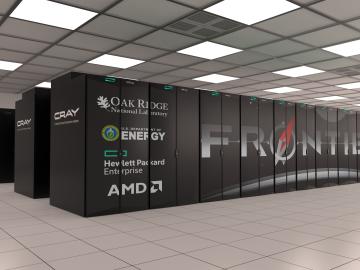
Filter News
Area of Research
- (-) National Security (25)
- (-) Supercomputing (39)
- Advanced Manufacturing (2)
- Biology and Environment (52)
- Biology and Soft Matter (1)
- Building Technologies (2)
- Clean Energy (49)
- Computational Biology (1)
- Computer Science (1)
- Electricity and Smart Grid (1)
- Functional Materials for Energy (2)
- Fusion and Fission (15)
- Isotopes (3)
- Materials (43)
- Materials for Computing (6)
- Neutron Science (14)
- Renewable Energy (1)
News Topics
- 3-D Printing/Advanced Manufacturing (1)
- Artificial Intelligence (9)
- Big Data (4)
- Bioenergy (3)
- Biology (7)
- Biomedical (4)
- Biotechnology (1)
- Buildings (3)
- Chemical Sciences (2)
- Climate Change (7)
- Computer Science (14)
- Coronavirus (4)
- Critical Materials (1)
- Cybersecurity (5)
- Decarbonization (2)
- Energy Storage (3)
- Environment (4)
- Exascale Computing (6)
- Frontier (7)
- Grid (5)
- High-Performance Computing (9)
- Machine Learning (8)
- Materials (8)
- Materials Science (5)
- Microscopy (2)
- Nanotechnology (3)
- National Security (13)
- Neutron Science (2)
- Partnerships (1)
- Physics (2)
- Quantum Computing (7)
- Quantum Science (4)
- Security (4)
- Simulation (5)
- Space Exploration (1)
- Summit (7)
- Sustainable Energy (2)
Media Contacts

Lawrence Berkeley National Laboratory physicists Christian Bauer, Marat Freytsis and Benjamin Nachman have leveraged an IBM Q quantum computer through the Oak Ridge Leadership Computing Facility’s Quantum Computing User Program to capture part of a

Unequal access to modern infrastructure is a feature of growing cities, according to a study published this week in the Proceedings of the National Academy of Sciences

ORNL scientists had a problem mapping the genomes of bacteria to better understand the origins of their physical traits and improve their function for bioenergy production.

A force within the supercomputing community, Jack Dongarra developed software packages that became standard in the industry, allowing high-performance computers to become increasingly more powerful in recent decades.

Computational users at the Oak Ridge Leadership Computing Facility, or OLCF, are running scientific codes on Frontier’s architecture in the form of a powerful test system at the OLCF called Crusher.

A study by researchers at the ORNL takes a fresh look at what could become the first step toward a new generation of solar batteries.

Scientists’ increasing mastery of quantum mechanics is heralding a new age of innovation. Technologies that harness the power of nature’s most minute scale show enormous potential across the scientific spectrum

Every day, hundreds of thousands of commuters across the country travel from houses, apartments and other residential spaces to commercial buildings — from offices and schools to gyms and grocery stores.

University of Pennsylvania researchers called on computational systems biology expertise at Oak Ridge National Laboratory to analyze large datasets of single-cell RNA sequencing from skin samples afflicted with atopic dermatitis.

A study led by researchers at ORNL used the nation’s fastest supercomputer to close in on the answer to a central question of modern physics that could help conduct development of the next generation of energy technologies.


